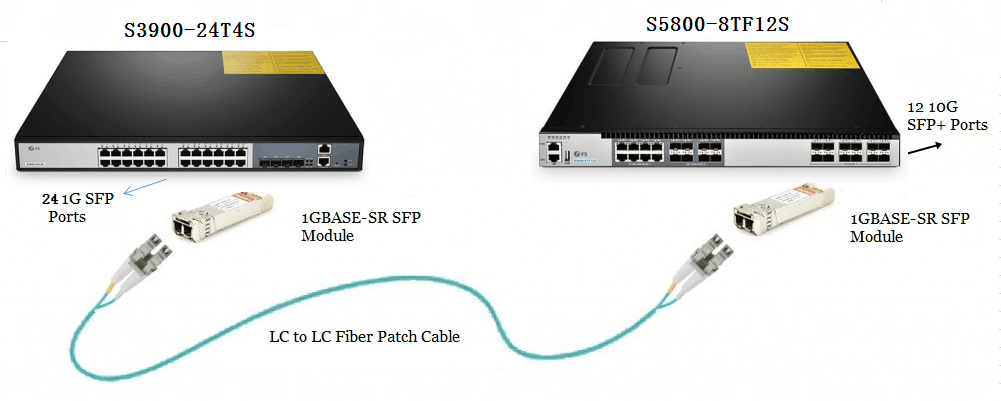

 Knowledge Base +
Knowledge Base +  2024.01.05
2024.01.05SFP 10G, also known as 10G SFP, is a standard form factor for 10 Gigabit Ethernet optical transceivers. It supports data rates of up to 10 Gbps and is used for various applications, including data center networking and telecommunications.
SFP+ 10G, also known as 10G SFP+, is an enhanced version of the SFP 10G form factor. It also supports data rates of up to 10 Gbps, but it offers additional features and improvements, such as better thermal design and electrical specifications. SFP+ 10G transceivers are commonly used in high-speed data center and enterprise networking applications.
In summary, the main difference between SFP 10G and SFP+ 10G is that SFP+ 10G is an enhanced and improved version of the standard SFP 10G form factor, offering additional features and performance improvements.
What is a QSFP port?
The QSFP or Quad Small Pluggable Transceiver is another type of compact hot-swappable transceiver. It supports Ethernet, Fibre Channel, InfiniBand and SONET/SDH standards with different data rate options. QSFP modules are typically available in several different types: 4x1Gbps QSFP, 4x10Gbps QSFP+, and 4x28Gbps QSFP28.
How do I choose an SFP transceiver?
In addition to SFP, SFP+ and QSFP, you also need to consider the application. there are different types of SFP transceivers, depending on their use, such as single mode and multimode SFP. singlemode SFP transceivers work with single-mode fibre, while multimode SFPs are compatible with multimode fibre. There are also long-range WDM SFP transceivers for multiplexing, simplex SFPs for single-fibre applications, video SFP transceivers for transmitting HD video, and PON SFP transceivers for fibre-based access networks. SFPs are available for commercial and extended operating temperature ranges, with or without extended diagnostic capabilities.
Can 10G SFP+ optics run at 1G SFP port?
Will 10Gb SFP+ running at 1Gb? The answer is definitely “No”. SFP optics do work in SFP+ slots in most cases, but SFP+ optics on 10Gb switch can never work in SFP slots on gigabit switch. The reason is about a power availability thing. As we know, once an module is installed, the speed of the port is decided. Most SFP+ slots are backward compatible with SFP modules to run at 1G speed. However, the SFP slots on gigabit switch cannot support the 10G speed required by SFP+ modules. For instance, most Cisco and FS 10Gb switches support 10G SFP+ and 1G SFP optics on their SFP+ ports. But some Brocade gear and HP A-series models are SFP+ only. One need to double check the compatibility of this switch with the vendor rep.
10Gb switch SFP+ port links to gigabit switch SFP port via 1G SFP modules and fiber patch cable.

SFP+ Optics in a 10Gb Switch Cannot Auto-negotiate Down to 1G when the Other End Is Gigabit Switch
Unlike copper SFP modules supporting 10/100/1000 auto-sensing, fiber optics do not support auto-negotiation. Because this technology is based on electrical pluses but not optical pluses. Thus 10Gb SFP+ optics on 10Gb switch can not auto-negotiate down to 1Gb if the other end is gigabit switch. In fact, most SFP and SFP+ transceivers only run at its rated speed and the transceivers at both end of the cable should at the same speed. For example, if a 10Gb SFP+ module is plugged into the 10Gb switch port, it will only run at 10Gb. In this case if you link it to the gigabit switch port, it will not work. When sticking a 1Gb SFP module in the 10G SFP+ port, the 10Gb switch will only run at 1Gb. As thus you can link it to gigabit switch.
Sometimes the 10GbE switch port would lock the speed at 1G until you reconfigure the switch to 10G. It is noted that SFP+ port usually enables a speed under 1G, which means one cannot insert 100Base SFP modules into SFP+ ports on 10Gb switch.
Subscribe to the newsletter
for all the latest updates.
2-5# Building, Tongfuyu Industrial Zone, Aiqun Road, Shiyan Street, Baoan District, Shenzhen. China
